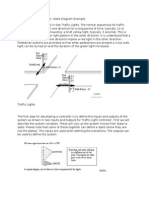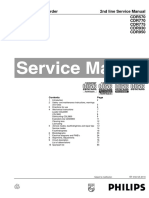Chapter 1 Notes
Chapter 1 Notes
Uploaded by
hero_spaceboy3600Copyright:
Available Formats
Chapter 1 Notes
Chapter 1 Notes
Uploaded by
hero_spaceboy3600Copyright
Available Formats
Share this document
Did you find this document useful?
Is this content inappropriate?
Copyright:
Available Formats
Chapter 1 Notes
Chapter 1 Notes
Uploaded by
hero_spaceboy3600Copyright:
Available Formats
The programmable logic controller is designed for multiple input and output arrangements, extended temperature ranges, immunity
to electrical noise, and resistance to vibration and impact. Programs for the control and operation of manufacturing process equipment and machinery are typically stored in battery-backed or non-volatile memory. A PLC is an example of a real-time system since the output of the system controlled by the PLC depends on the input conditions. PLCs are capable not only of performing relay switching tasks but also of performing other applications such as timing, counting, calculating, comparing, and the processing of analog signals. Relays have to be hardwired to perform a specific function. When the system requirements change, the relay wiring has to be changed or modified. In extreme cases, such as in the auto industry, complete control panels had to be replaced since it was not economically feasible to rewire the old panels with each model changeover. Increased Reliability. Once a program has been written and tested, it can be easily downloaded to other PLCs. Since all the logic is contained in the PLCs memory, there is no chance of making a logic wiring error (Figure 1-3). The program takes the place of much of the external wiring that would normally be required for control of a process. Hardwiring, though still required to connect field devices, is less intensive. PLCs also offer the reliability associated with solid-state components. More Flexibility. It is easier to create and change a program in a PLC than to wire and rewire a circuit. With a PLC the relationships between the inputs and outputs are determined by the user program instead of the manner in which they are interconnected. Lower Cost. PLCs were originally designed to replace relay control logic, and the cost savings have been so significant that relay control is becoming obsolete except for power applications. Generally, if an application has more than about a half-dozen control relays, it will probably be less expensive to install a PLC. Communications Capability. A PLC can communicate with other controllers or computer equipment to perform such functions as supervisory control, data gathering, monitoring devices and process parameters, and download and upload of programs. Faster Response Time. PLCs are designed for high- speed and real-time applications (Figure 1-6). The programmable controller operates in real time, which means that an event taking place in the field will result in the execution of an operation or output. Machines that process thousands of items per second and objects that spend
only a fraction of a second in front of a sensor require the PLCs quick-response capability. Easier to Troubleshoot. PLCs have resident diagnostics and override functions that allow users to easily trace and correct software and hardware problems. To find and fix problems, users can display the control program on a monitor and watch it in real time as it executes. PLC components: CPU, I/O and power supply. Architecture refers to hardware, software or both. Open architecture means the system can be connected to devices and programs made by other manufacturers (with any standard off-the-shelf device). Close architecture means the systems is proprietary making is more difficult to connect to other systems. Most PLCs are proprietary. Fixed I/O is used for small PLCs, which come with a package that includes the CPU as well. The I/O has a fixed number of connections built in. Its cheaper but if any part in the unit fails the whole system must be replaced. The disadvantage is flexibility which means we are limited to what we can get in quantity or types dictated by the packaging. Modular I/O is divided by compartments into which separate modules can be plugged. This increases the flexibility. The basic modular controller consists of a rack, power supply, CPU, I/O and an operators interface. For large systems a separate power supply is needed for the field devices. Program cycle: readying the status of inputs, executing the program, perform internal diagnostic and communication tasks and finally updating the status of outputs. I/O systems form the interface by which the field devices are connected to the controller. Optoisolators are used to isolate the internal systems from the I/O devices to protect the internal devices. The external devices are referred to as field or real-world input and output. Relay ladder logic is the programming language used to program PLCS. A PC or a hand-held programming device is used to write, modify and monitor a program. Hand-held devices are inexpensive and easy to use and are used in factory floor mostly. PLCs unlike personal computers are designed to work in industrial environment with wide range of ambient temperature and immune to electrical noise. Also no keyboard or CD drive is permanently attached to them. Instead they are equipped with I/O and communication ports. PLC software run on a PC is used to program the PLC in ladder logic or any other programming language. PLC software run on a PC also allows the user to monitor and control the process (human machine interface, HMI). Using programmable automation controller (PAC) you can build advanced systems incorporating software capabilities such as advanced control, communication, data
logging, and signal processing by combining advantages of PLC systems and PCbased systems. Cost is highly dependent on number of I/Os. I/O sizes: nano (<15),micro(15-128), medium (128-512) and large (512<). Should consider future conditions. Three types of PLC applications: single-ended, multitask and control management. Single-ended or stand alone PLC application involves one PLC controlling one process. This would be a stand-alone unit and would not be used for communicating with other PLCs or PCs. Multitask PLC applications involves one PLC controlling several process. Adequate I/O is very important. If the PLC is a subsystem of a larger system it has to communicate with the central PLC or computer. Central management PLC applications involve one PLC controlling several others. This application requires a large PLC processor designed for communicating with other PLCs. This PLC tells other PLCs what has to be done based on the program downloaded into its memory. Memory size depends on: # of I/O, size of program, data-collecting requirements, supervisory functions required and future expansions.
You might also like
- RSLogix5000 V17 20080620Document39 pagesRSLogix5000 V17 20080620Rinalyn-Oscar Gamboa MagtibayNo ratings yet
- Local Control Unit DCS PDFDocument44 pagesLocal Control Unit DCS PDFSaravanakumar K100% (1)
- Programmable Logic Controller PLCDocument53 pagesProgrammable Logic Controller PLCokk chuNo ratings yet
- Complete Report1 PLCDocument90 pagesComplete Report1 PLCRao Arslan Rajput100% (3)
- PLC and HMI Development with Siemens TIA Portal: Develop PLC and HMI programs using standard methods and structured approaches with TIA Portal V17From EverandPLC and HMI Development with Siemens TIA Portal: Develop PLC and HMI programs using standard methods and structured approaches with TIA Portal V17No ratings yet
- Mastering Siemens S7: A Comprehensive Guide to PLC ProgrammingFrom EverandMastering Siemens S7: A Comprehensive Guide to PLC ProgrammingNo ratings yet
- PLC Industrial Training FileDocument22 pagesPLC Industrial Training FileROHIT MishraNo ratings yet
- PLC ScadaDocument43 pagesPLC Scadaabhijeet100% (1)
- Siemens Mechatronic Systems Certification ProgramDocument1 pageSiemens Mechatronic Systems Certification Programbagitkaliev88No ratings yet
- PLC Interview Questions: 1. What Is The RS LINX Software Used For?Document5 pagesPLC Interview Questions: 1. What Is The RS LINX Software Used For?Pradip ChauhanNo ratings yet
- PLC 612 Lab ManualDocument35 pagesPLC 612 Lab ManualPriyank SunhareNo ratings yet
- In The Name of Allah The Most Benificet and The Most MercifulDocument24 pagesIn The Name of Allah The Most Benificet and The Most MercifulAsad RazaNo ratings yet
- PLC AutomationDocument18 pagesPLC AutomationRavi JoshiNo ratings yet
- PLC - L1Document25 pagesPLC - L1MASOUDNo ratings yet
- Training Curriculum: TIA Portal Module 002Document46 pagesTraining Curriculum: TIA Portal Module 002Hải Nguyễn KhắcNo ratings yet
- Air Polution Control - Project (Rockwell)Document16 pagesAir Polution Control - Project (Rockwell)Chandan MandalNo ratings yet
- Simatic S7-300 DiagnosticsDocument49 pagesSimatic S7-300 Diagnostics相澤レンNo ratings yet
- Sinamics v90 PDFDocument364 pagesSinamics v90 PDFSharon ShajiNo ratings yet
- A Presentation On Scada System: (Supervisory Control and Data Acquisition)Document19 pagesA Presentation On Scada System: (Supervisory Control and Data Acquisition)Anis MaqboolNo ratings yet
- CodesysDocument22 pagesCodesysJacob B ChackoNo ratings yet
- PLC Motor LogicDocument5 pagesPLC Motor LogicInstrumentation ToolsNo ratings yet
- PLC Reviewer PDFDocument6 pagesPLC Reviewer PDFDhafnylynn MacasaetNo ratings yet
- Industrial Automation Using PLCs - System Design ProblemsDocument3 pagesIndustrial Automation Using PLCs - System Design ProblemsBonface MugwiraNo ratings yet
- Lab 10Document5 pagesLab 10Abdolkarim PahlianiNo ratings yet
- Partners Training Motor Starters SessionDocument43 pagesPartners Training Motor Starters SessionAzmyAbdelmaneamNo ratings yet
- Instrumentation and ControlDocument25 pagesInstrumentation and ControlPTk Daryl Cabañero TayongNo ratings yet
- Traffic Lights PLC ControlDocument9 pagesTraffic Lights PLC ControlabiyotaderieNo ratings yet
- On Basic PLCDocument18 pagesOn Basic PLCpadala harishnath100% (1)
- Portable PLC Troubleshooting Training - Siemens S71200 Ebook CurriculumDocument3 pagesPortable PLC Troubleshooting Training - Siemens S71200 Ebook CurriculumMd. ArifNo ratings yet
- Industrial TrainingDocument26 pagesIndustrial TrainingHarsh RanaNo ratings yet
- Design Projects in A PLCDocument10 pagesDesign Projects in A PLCSam B.medNo ratings yet
- Project Report of Laser Security Alarm SystemDocument25 pagesProject Report of Laser Security Alarm SystemB LIKHITH KUMARNo ratings yet
- Logix Wp008 en PDocument27 pagesLogix Wp008 en PAnonymous YhFsrjunV0No ratings yet
- 3ADR010429, 1, en - US - AC500 - PLC - Infrastructure - Automation - Solutions - LowresDocument24 pages3ADR010429, 1, en - US - AC500 - PLC - Infrastructure - Automation - Solutions - LowresKhaled EbaidNo ratings yet
- PLCDocument84 pagesPLCsasikumarmarineNo ratings yet
- Course Description SMSCP L2Document2 pagesCourse Description SMSCP L2Zdravko PeranNo ratings yet
- PLC Manual - 1803096 - Mayank Shahabadee - FINALDocument72 pagesPLC Manual - 1803096 - Mayank Shahabadee - FINALMayank Shahabadee67% (3)
- Types Profibus CommunicationDocument23 pagesTypes Profibus CommunicationAhmed ElsayedNo ratings yet
- Simatic Step 7 DownloadDocument3 pagesSimatic Step 7 DownloadZdravko PeranNo ratings yet
- Design of Pid Controller For PLC: J. Paulusová, L. KörösiDocument8 pagesDesign of Pid Controller For PLC: J. Paulusová, L. Körösiankit407No ratings yet
- Allen Bradley InterfaceDocument10 pagesAllen Bradley Interfacemsalem73100% (1)
- PLC Interview QuestionsDocument8 pagesPLC Interview QuestionsShiva Prakasam Perneti100% (1)
- LM Parameter Reference Dictionary LM09640Document114 pagesLM Parameter Reference Dictionary LM09640webav1724No ratings yet
- Iec61131 3Document37 pagesIec61131 3spfallasNo ratings yet
- PLCQDocument2 pagesPLCQdenramrNo ratings yet
- Industrial Automation Engineers Interview QuestionsDocument5 pagesIndustrial Automation Engineers Interview QuestionsJêmš NavikNo ratings yet
- Programmable Logic Controller (PLC) - Industrial Wiki - ODESIE® by Technology TransferDocument41 pagesProgrammable Logic Controller (PLC) - Industrial Wiki - ODESIE® by Technology TransferAbhishek SinghNo ratings yet
- PLCDocument11 pagesPLCGeorge PaulNo ratings yet
- Training Program On Programmable Logic ControllerDocument28 pagesTraining Program On Programmable Logic ControllerHimanish GuptaNo ratings yet
- CCP410 - PLC-5 and RSLogix 5 ProgrammingDocument2 pagesCCP410 - PLC-5 and RSLogix 5 Programmingاحتشام چوہدریNo ratings yet
- PLC Based Inspection, Packaging and Storing of MaterialsDocument5 pagesPLC Based Inspection, Packaging and Storing of MaterialsAlauddin khanNo ratings yet
- L01 - Introduction To Studio 5000 Logix DesignerDocument12 pagesL01 - Introduction To Studio 5000 Logix Designermarcelodias99100% (1)
- Rslogix 500 V1.0 18.06.2013Document85 pagesRslogix 500 V1.0 18.06.2013Arvind KumarNo ratings yet
- 4 PLCDocument31 pages4 PLCThakur Dhananjay PratapNo ratings yet
- (PME) Latest PME Cumulative and Security Updates Available - Exchange CommunityDocument4 pages(PME) Latest PME Cumulative and Security Updates Available - Exchange CommunityMiguel Huaccha ArmasNo ratings yet
- WinCC V7.5 Orderdata EuDocument2 pagesWinCC V7.5 Orderdata EufaisalrahmadNo ratings yet
- Arduino Based Automatic Pneumatic SystemDocument31 pagesArduino Based Automatic Pneumatic Systemnklharish1No ratings yet
- Technical Information Tankvision NXA820, NXA821, NXA822Document16 pagesTechnical Information Tankvision NXA820, NXA821, NXA822Jhon Anderson Arango Rodriguez100% (1)
- Final Year Projects List - PLC and SCADADocument4 pagesFinal Year Projects List - PLC and SCADAEnsemble Technologies83% (6)
- PLC CurriculumDocument4 pagesPLC CurriculummanisegarNo ratings yet
- Quidway AR 4945 Router System DescriptionDocument55 pagesQuidway AR 4945 Router System DescriptionLeoHuirseNo ratings yet
- Research On The Virtualization Technology in Cloud Computing EnvironmentDocument7 pagesResearch On The Virtualization Technology in Cloud Computing Environment30. Rafiya Asmatpasha PatelNo ratings yet
- 11th Computer Science EM WWW - Tntextbooks.inDocument328 pages11th Computer Science EM WWW - Tntextbooks.inIsaac Joel RajNo ratings yet
- System Verilog: Bavu Vamshi KrishnaDocument11 pagesSystem Verilog: Bavu Vamshi Krishna1am17ec014 ashnal ahmedNo ratings yet
- Compact Disc Recorder 2nd Line Service Manual CDR570 CDR770 CDR775 CDR930 CDR950Document98 pagesCompact Disc Recorder 2nd Line Service Manual CDR570 CDR770 CDR775 CDR930 CDR950ryosaeba666No ratings yet
- Industrial VFD Codes by SimensDocument4 pagesIndustrial VFD Codes by SimensSanthosh RasaNo ratings yet
- CMOS VLSI Design 192Document1 pageCMOS VLSI Design 192Carlos SaavedraNo ratings yet
- External Dimensions 1 ...... FM20: Absolute Maximum Ratings Electrical CharacteristicsDocument2 pagesExternal Dimensions 1 ...... FM20: Absolute Maximum Ratings Electrical CharacteristicsytnateNo ratings yet
- Amazon Web Services Certification Guide: Needed Recommended OptionalDocument1 pageAmazon Web Services Certification Guide: Needed Recommended OptionalnagaratnareddyNo ratings yet
- EXFO Reference-Poster Raman V1 enDocument3 pagesEXFO Reference-Poster Raman V1 enBoy Tai HinNo ratings yet
- Inverters PDFDocument90 pagesInverters PDFYasir HarafathNo ratings yet
- Getting Started With PIC Microcontroller - CCS C Compiler PDFDocument19 pagesGetting Started With PIC Microcontroller - CCS C Compiler PDFNithya100% (2)
- Introduction To Computer Applications NotesDocument132 pagesIntroduction To Computer Applications NotesrooneyboraNo ratings yet
- Computer StudyDocument45 pagesComputer StudyOlushola AdebisiNo ratings yet
- Computing Ds 8Gb DDR4 (A-Ver) Based UDIMMs (Rev.1.3) PDFDocument73 pagesComputing Ds 8Gb DDR4 (A-Ver) Based UDIMMs (Rev.1.3) PDFBaboushka DalalNo ratings yet
- LE1004 Manual EngDocument71 pagesLE1004 Manual Engsmartlink79No ratings yet
- SEM III BR Computer Science and EngineeringDocument21 pagesSEM III BR Computer Science and EngineeringyogeshNo ratings yet
- Commvaultbest Practices For Cybersecurity Threat ProtectionDocument3 pagesCommvaultbest Practices For Cybersecurity Threat ProtectionUmas GalaNo ratings yet
- Scalability and Heterogeneity: Colin PerkinsDocument25 pagesScalability and Heterogeneity: Colin PerkinsBARUTI JUMANo ratings yet
- Ev Radar Mmic2 - Ug 866 938712Document29 pagesEv Radar Mmic2 - Ug 866 938712bardarisNo ratings yet
- Avg Data Rate To Browsers: 1.50 MbpsDocument2 pagesAvg Data Rate To Browsers: 1.50 MbpsRayhan AhmedNo ratings yet
- Raab - 1987 - Efficiency of Doherty RF Power-Amplifier SystemsDocument7 pagesRaab - 1987 - Efficiency of Doherty RF Power-Amplifier SystemsJose Antonio Garcia PerezNo ratings yet
- Course Title: Programming FundamentalsDocument2 pagesCourse Title: Programming FundamentalsMicrosoft WelfareNo ratings yet
- Netwrix Auditor v10.5 10-16-2022Document5 pagesNetwrix Auditor v10.5 10-16-2022Celestin TSHISHINo ratings yet
- Distributed Scheduling&Load BalancingDocument54 pagesDistributed Scheduling&Load BalancingSubhadharshini KarthikeyanNo ratings yet
- Linux AdministrationDocument1 pageLinux AdministrationDreamtech Press100% (1)
- Veritas NetBackup Benchmark Comparison: Data Protection in A Large-Scale Virtual Environment (Part 1)Document22 pagesVeritas NetBackup Benchmark Comparison: Data Protection in A Large-Scale Virtual Environment (Part 1)Principled TechnologiesNo ratings yet
- Badi 2Document3 pagesBadi 2khanmdNo ratings yet
- DX DiagDocument32 pagesDX DiagDimitrije MijatovicNo ratings yet
- Stid 337Document3 pagesStid 337Hakan SyblNo ratings yet

























































































